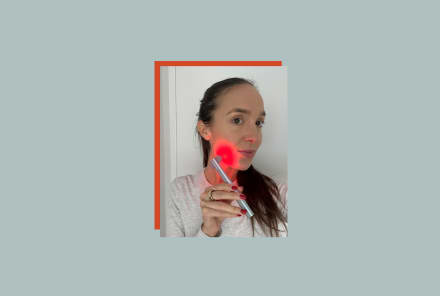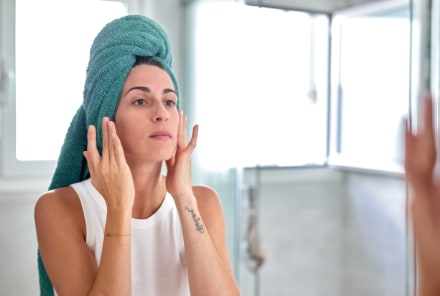Advertisement
Our Guide To Treating Every Type Of Inflammatory Acne, Backed By Derms


As lovely as it sounds to zap away zits as quickly as possible, treating acne often takes much more patience and care—and you can't treat all blemishes the same way. For example: Some spots can handle a regular exfoliating regimen to lift debris from the pores, while others require much gentler methods to soothe the skin and tackle acne-causing bacteria. The latter is best for breakouts that are painful, swollen, and just plain inflamed—and that's the kind we're going to dive into today.
Ahead, find our full guide to inflammatory acne, including how to I.D. the blemish and the best ways to treat it.
What is inflammatory acne?
Actually, the term is a bit inaccurate. Because technically, all acne stems from some level of inflammation: Even with those subtler whiteheads and blackheads, an overgrowth of bacteria (specifically Cutibacterium acnes1) can cause the release of inflammatory cytokines and messengers to create clinical inflammation. So even "non-inflammatory" acne can become inflamed later on.
However, a few types of pimples are more puffy and angry than others—those are what we classify as "inflammatory," as they aesthetically align with what you might imagine an inflamed zit to look like: red, swollen, and tender to the touch.
Types of inflammatory acne.
To familiarize yourself with all the types of breakouts (non-inflammatory and inflammatory), we highly suggest taking a peek at our full acne guide. But for a quick refresh, let's discuss some inflammatory bumps below:
- Papules: "Papules look like solid red bumps, while pustules have pus at the top," board-certified dermatologist Zenovia Gabriel, M.D., FAAD, says regarding forehead acne. Think of the stereotypical red-colored bump you may associate with acne—that's a papule.
- Pustules: Papules often turn into pustules. When the red papule forms a white, pus-filled head, you now have a tender pustule. People often mistake this white head as, well, a "whitehead," but in clinical derm-speak, those are two very different things.
- Cysts: Cystic acne is characterized by inflamed lesions, often large in size, that form deep within the skin—but unlike other forms of acne, they never come to a head on the surface. And unlike hard nodules, cysts can be soft to the touch (in fact, they're often puffy and tender).
- Nodules: Nodules are firmer than cysts and are also more widespread than typical pimples. Cosmetic and general dermatologist at Marmur Medical Rachel Maiman, M.D., says this type of acne, "often feels like firm knots under the skin and can be found on the face and body." They look like hard lesions that feel like lumps under the skin; and while they may be flesh-toned or red, they're often pretty painful to the touch.
How to treat it.
Everyone's skin is unique, but these are the general tips derms recommend time and again:
Use ingredients with antimicrobial properties.
In terms of star ingredients, derms often tout benzoyl peroxide as especially helpful for angry papules and pustules. "It kills the acne-causing bacteria [C. acnes] that lives within our hair follicles, and it also helps to break up and remove dead skin cells that clog our pores," Ife Rodney, M.D., a board-certified dermatologist and founder of Eternal Dermatology, says regarding the ingredient.
Tea tree oil deserves honorable mention, too: The essential oil boasts some antimicrobial properties and is capable of lowering levels of acne-causing bacteria on the skin when applied to acne lesions. One double-blind placebo-controlled study even found that a 5% tea tree oil gel blend was an effective treatment for mild to moderate acne2. It also simultaneously soothes the skin with its anti-inflammatory properties—which is just as important when treating angry, tender acne. Just make sure to always dilute straight tea tree oil with a carrier, as you never want to apply essential oils directly on the skin.
Use calming, anti-inflammatory ingredients.
Which brings us to our next point: To treat inflammatory acne, you'll want to use a mix of acne-fighting and soothing ingredients to help dial down the inflammation. We'd be remiss not to give aloe vera its worthy praise, as the gel is chock-full of anti-inflammatory vitamins, enzymes, minerals, and amino acids to soothe angry pimples. (Plus, it also contains natural salicylic acids to help unplug the acne at the source.)
Derms also love chamomile to help bring down the swelling. "When used in topical skin care products, chamomile can help calm and soothe the skin," board-certified dermatologist Joyce Park, M.D., tells mbg. Some even say chamomile is helpful for shrinking cystic pimples—the jury's still out on that trick, as the inflammation runs quite deep, but it makes sense the ingredient would soothe any tenderness.
Here's our favorite moisturizers for those with acne.
Spot treat.
Here's a little tip to help shrink a pimple overnight: Grab any serum, mask, or spot treatment with acne-fighting ingredients (salicylic acid, tea tree oil, benzoyl peroxide, and the list goes on), and tap it on to the spot before bed. Even if you don't use a marketed "spot treatment," the extra dose can help unclog the breakout while you snooze.
You can also cover up spots with an acne patch, if you choose. These are made of hydrocolloid, a medical dressing that absorbs excess fluid (like oil and pus) without drying out the skin. They're especially helpful on pustules (those have the white, pus-filled bumps, remember?) as the patch can suck out all the gunk without ripping the skin.
Use ice.
An age-old remedy to quickly bring down swelling: ice. The cool temperature constricts the circulation, limiting flow to the area and retracting the inflammation—plus, it just feels nice on an irritated, tender zit. Be sure to wrap the ice cube in a tissue or towel before placing it onto the blemish, as you don't want to completely shock your skin—this can only lead to more inflammation, which is the opposite of what you want here.
Tend to hyperpigmentation.
If you've struggled with acne, you likely know: Dealing with dark spots and acne scars can often take more time and effort than the breakout itself. And the deeper the inflammation is, the more prone the blemish is to scarring. (Generally, nodules and cysts have a higher risk.)
We have a whole guide to treating acne scars here, but derms often recommend brightening ingredients (like vitamin C or arbutin) to help fade those marks over time, as well as retinoids. In addition to exfoliating dead skin cells and keeping breakouts at bay, retinoids block the activity of enzymes3 behind melanin synthesis, resulting in a more even skin tone.
Manage lifestyle factors, like sleep, stress & diet.
As we mentioned, all acne stems from some sort of inflammation. And since your diet, stress levels, and sleep (or lack thereof) can all affect your body's inflammatory response, they can carry some significant weight when it comes to your skin. Your skin is a reflection of your internal health, after all.
Now, I'm not going to hide behind my keyboard and tell you that tending to these lifestyle factors is easy (it's definitely not!), but understanding the role sleep, stress, and diet play in your skin health is the first step to ultimately managing it. And if you're unsure where to start, we have a handy guide to help.
See a derm.
Acne is a very complex condition, and so it's difficult to pinpoint an exact treatment for everyone. If you can, we recommend seeing a derm who can take a look at your skin and lifestyle and offer the best treatment plan—especially if you're dealing with nodules or cysts, as OTC acne treatments won't be as effective.
The takeaway.
Treating all forms of acne takes time and patience, but caring for inflammatory pimples requires even more of a balance—you want to clear the blemish with acne-fighting ingredients without making the blemish even angrier. These derm-backed tips above can help, but most of all, don't try to pop or squeeze the lesions: All experts can agree that's a major acne mistake.
Watch Next
Enjoy some of our favorite clips from classes
Enjoy some of our favorite clips from classes
What Is Meditation?
Mindfulness/Spirituality | Light Watkins
Box Breathing
Mindfulness/Spirituality | Gwen Dittmar
What Breathwork Can Address
Mindfulness/Spirituality | Gwen Dittmar
The 8 Limbs of Yoga - What is Asana?
Yoga | Caley Alyssa
Two Standing Postures to Open Up Tight Hips
Yoga | Caley Alyssa
How Plants Can Optimize Athletic Performance
Nutrition | Rich Roll
What to Eat Before a Workout
Nutrition | Rich Roll
How Ayurveda Helps Us Navigate Modern Life
Nutrition | Sahara Rose
Messages About Love & Relationships
Love & Relationships | Esther Perel
Love Languages
Love & Relationships | Esther Perel
-v1646695196476.jpg?1148x800)

















